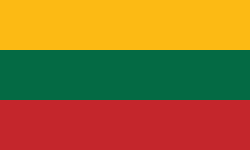Linkuva
 |
The lands were inhabited by a Baltic tribe, the Semigallians. Linkuva was first mentioned in 1371 in Livonian chronicles by Hermann von Wartberge. Linkuva and its environs suffered from pillaging and attacks by the Livonian Order. The owner of Linkuva manor, Kotryna Mykolienė, built a church in 1500. Later it was taken over by Calvinists.
In documents from 1605, a continental Reformed church is mentioned. A parish school operated in the second part of the 16th century and in the beginning of the 19th century. In 1634, a Carmelite monastery was established; it closed in 1832.
In the spring of 1918, Linkuva hoster one of the first demonstrations for Lithuanian independence, supporting the Council of Lithuania. In 1919 the town was taken by Bermontians, but Linkuva volunteers helped to regain it for Lithuania. In 1923, the gymnasium of Linkuva was established, which became well known in northern Lithuania. In 1937, a town library was established.
In 1940, after the occupation of Lithuania by the USSR, all the town's factories and stores were nationalized and deportations started. On June 23, 1941, after Nazi German invasion and the Soviet withdrawal from Lithuania, hundreds of Jews escaping eastward from Šiauliai and the neighboring towns found refuge in Linkuva and remained there. Most of the town's Jews were forcibly held in stables and warehouses, where they were brutally attacked. In the summer of 1941, 200 Jewish men were killed near the village of Dvariūkai. The victims came from Linkuva, along with Jewish refugees who had fled to the village.
Soviet occupants in 1940–41 and in 1944–53 deported 30 people from Linkuva. After the World War II the Soviet Army stationed 150 soldiers in Lunkuva to fight Lithuanian partisans. After the Soviet occupation, around Linkuva Lithuanian partisans of Resurrection (Prisikėlimas) military district were active.
Map - Linkuva
Map
Country - Lithuanian_Soviet_Socialist_Republic_(1918–1919)
 |
 |
| Flag of Lithuania | |
Germany had lost World War I and signed the Compiègne Armistice on 11 November 1918. Its military forces then started retreating from the former Ober Ost territories. Two days later, the government of the Soviet Russia renounced the Treaty of Brest-Litovsk, which had assured Lithuania's independence. Soviet forces then launched a westward offensive against Estonia, Latvia, Lithuania, Poland and Ukraine in an effort to spread the global proletarian revolution and replace national independence movements with Soviet republics. Their forces followed retreating German troops and reached Lithuania by the end of December 1918.
Currency / Language
| ISO | Currency | Symbol | Significant figures |
|---|---|---|---|
| EUR | Euro | € | 2 |
| ISO | Language |
|---|---|
| LT | Lithuanian language |
| PL | Polish language |
| RU | Russian language |















